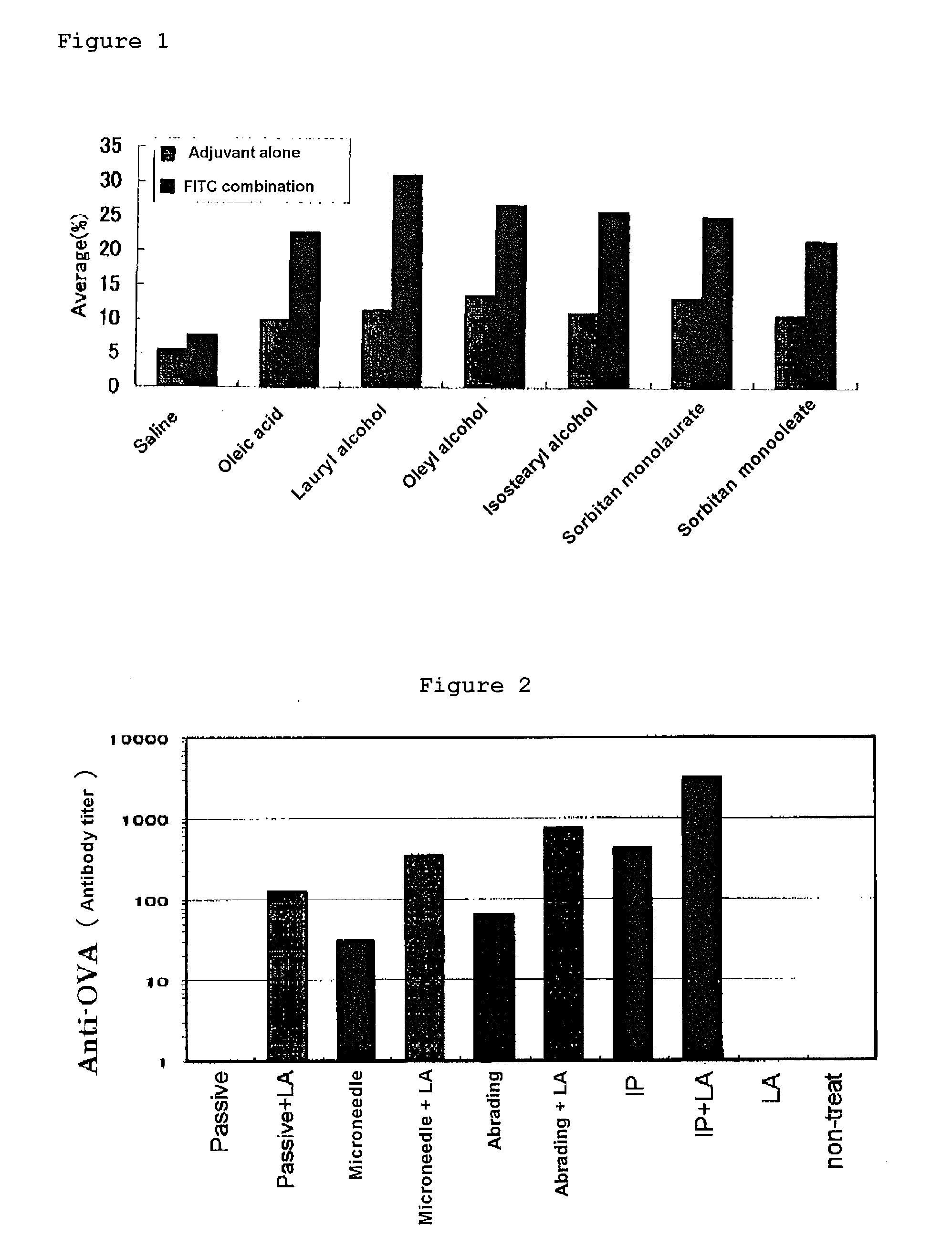Adjuvant for Transdermal or Transmucosal Administration and Pharmaceutical Preparation Containing the Same
a transdermal or transmucosal administration and pharmaceutical preparation technology, applied in the direction of sheet delivery, antibody medical ingredients, infusion needles, etc., can solve the problems of depot-forming adjuvants, induced subcutaneous nodules and granulomas, and aluminum salt absorbability problems, so as to enhance and improve the immunogenicity of the antigen.
- Summary
- Abstract
- Description
- Claims
- Application Information
AI Technical Summary
Benefits of technology
Problems solved by technology
Method used
Image
Examples
example 1
[0109]The abdominal hair of a male BALB / c mouse of seven to eight weeks old was shaved and 50 μL of acetone solution (50%) of the candidate adjuvant (oleic acid, lauryl alcohol, oleyl alcohol, isostearyl alcohol, sorbitan monolaurate, sorbitan monooleate) was administered (applied) transdermally (an adjuvant independent group). On the other hand, in the group of combination of an antigen and hapten, 50 μL of 1:1 mixed solution of FITC solution (5 mg / mL in acetone) and each adjuvant solution was administered transdermally in the abdominal region (FITC combination group). Five days later, a lymph node (cervical and inguinal) was extirpated, which was analyzed with flow cytometry for the expression strength of the MHC Class II molecule of the lymph cell (FIG. 1).
[0110]As shown in FIG. 1, transdermal administration of the low molecular adjuvant of free fatty acid (oleic acid), fatty acid esters (sorbitan monolaurate, sorbitan monooleate) and aliphatic alcohols (lauryl alcohol, oleyl alc...
example 2
[0111]The abdominal hair of a male BALB / c mouse of seven to eight weeks old was shaved and the degree of the skin irritation of the group to which each 25 μL of the candidate adjuvant (lauryl alcohol, oleyl alcohol, isostearyl alcohol, octyl dodecanol, polyethylene glycol monolaurate, sorbitan monolaurate) (undiluted solution) was administered intracutaneously, and the group to which 50 μL of acetone solution (50%) was administered (applied) transdermally, was evaluated with scores (Table 1).
[0112]As shown in Table 1, it was confirmed that, in transdermal administration of each low molecular adjuvant of fatty acid esters (polyethylene glycol monolaurate, sorbitan monolaurate) and of aliphatic alcohols (lauryl alcohol, oleyl alcohol, isostearyl alcohol, octyl dodecanol), skin irritation was not detected, and that safety was much higher than intracutaneous administration.
TABLE 1Skin irritation score (intracutaneous administrationversus transdermal administration)Skin irritationSkin ir...
example 3
[0113]The abdominal hair of a male BALB / c mouse of seven to eight weeks old was shaved, which was divided into untreated group and a group to which the antigen was administered intracutaneously. OVA (an antigen: Ovalbumin, Sigma Company) was prepared by dissolving it in physiological saline to give 10 μg / head, and to the OVA alone group, 25 μL of OVA aqueous solution was administered intracutaneously. To the group in which various kinds of adjuvants (lauryl alcohol, oleyl alcohol, isostearyl alcohol, octyl dodecanol, polyethylene glycol monolaurate and Freund complete adjuvant (FCA)) were used in combination, immediately after OVA solution was administered intracutaneously, 25 μL of each adjuvant solution was administered (applied) transdermally on the abdominal skin surface. Administration was carried out 0, 2 and 4 weeks later, and blood collection was carried out 2, 4 and 5 weeks later, and OVA specific IgG antibody titer after 2, 4 and 5 weeks was measured by ELISA. As the resul...
PUM
| Property | Measurement | Unit |
|---|---|---|
| Time | aaaaa | aaaaa |
| Unsaturation | aaaaa | aaaaa |
| Immunostimulation | aaaaa | aaaaa |
Abstract
Description
Claims
Application Information
 Login to View More
Login to View More - R&D
- Intellectual Property
- Life Sciences
- Materials
- Tech Scout
- Unparalleled Data Quality
- Higher Quality Content
- 60% Fewer Hallucinations
Browse by: Latest US Patents, China's latest patents, Technical Efficacy Thesaurus, Application Domain, Technology Topic, Popular Technical Reports.
© 2025 PatSnap. All rights reserved.Legal|Privacy policy|Modern Slavery Act Transparency Statement|Sitemap|About US| Contact US: help@patsnap.com



